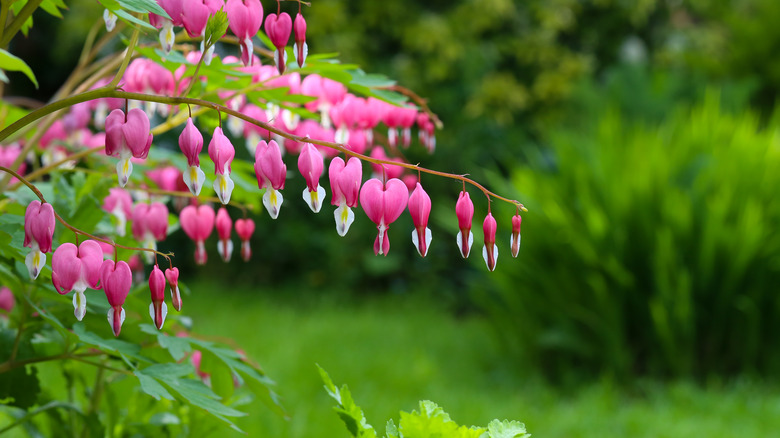When Is The Best Time To Divide Bleeding Hearts In Your Garden?
Although the name may sound a little gruesome, the puffy flowers of bleeding hearts (Dicentra spectabilis) certainly are not. This beautiful blooming perennial offers full foliage with floral stems dripping in heart-shaped blooms that — as the name implies — appear split with a single drop emerging from the bottom. This East Asian native is a stunning addition to both wildflower gardens and carefully manicured landscapes.
When the blooms are left to dry, they will reseed, but since it is a bushy perennial, it can take a few years for the plant to mature and bloom. Because of this, most people prefer to divide existing plants. This process actually benefits everyone because bleeding hearts perform best when they are divided about every five years. You can use these divisions to expand your own garden or gift them to friends. You can divide bleeding hearts in the early spring before they have bloomed or in the fall after the green leaves and stems have died back.
How to divide bleeding hearts
To divide your bleeding heart plants in the spring, wait until they begin to emerge from the ground. When they are just a few inches tall, soak the soil with water the night before you plan to make your divisions, then dig up the entire plant — roots and all. Since dirty tools can spread disease, clean your garden knife with hot soapy water and wipe it down with an alcohol-soaked cotton ball to ensure it is sanitized. Carefully cut the root section in half; if your plant is very large, you can cut it into three pieces.
If you plan to wait until fall to divide your bleeding hearts, you may need to mark their location with a decorative item or a garden marker so you know where to dig after all the foliage is gone. Just like in the spring, you will dig up the entire root system and cut it in half or in thirds with a clean knife.
Planting bleeding heart divisions
After you divide your bleeding hearts in the spring, you can replant the portion you want to keep in the same location and decide what you want to do with the others. If you are not transplanting them immediately, place them in a container with potting soil to keep them healthy while they wait for their permanent home. Transplanting is the perfect time to work some amendments, like compost, into the soil to promote even more blooms. After you place your newly divided plant in the ground, water thoroughly.
Prepare your soil for the tubers of fall-divided plants by digging a hole about 8 inches deep and twice as wide as the section of roots you are planting. Mix the soil with some compost and backfill the hole so you can place the tuber about 2 inches below the surface of the soil. Make sure the eyes — the nubs on the root piece that will form stems in the spring — are pointing up, and fill the rest of the hole with your amended soil. Water well and mark the location so you do not accidentally dig them up or damage them before they emerge in the spring.

